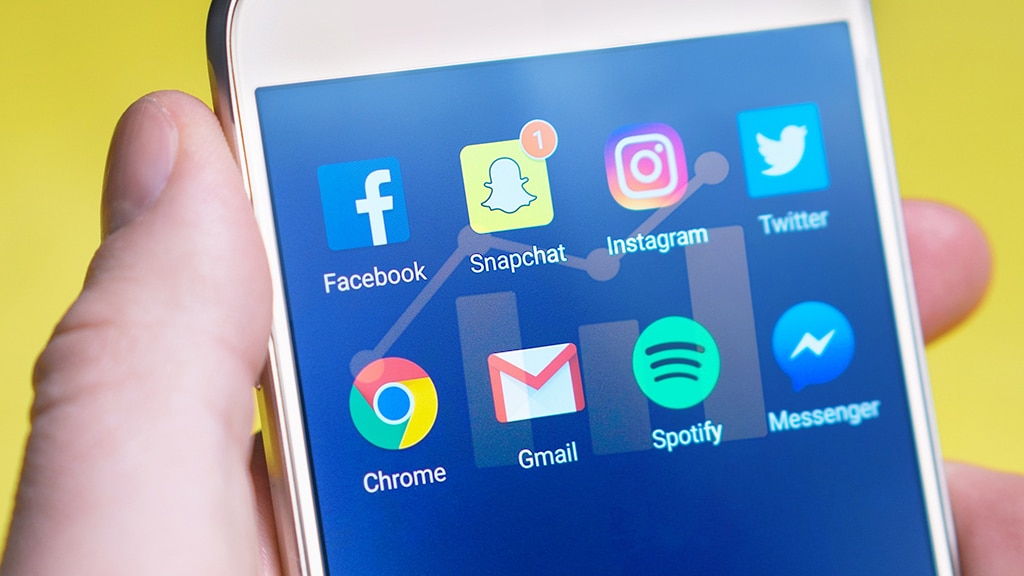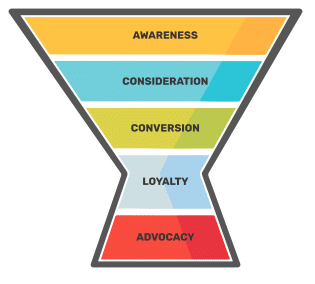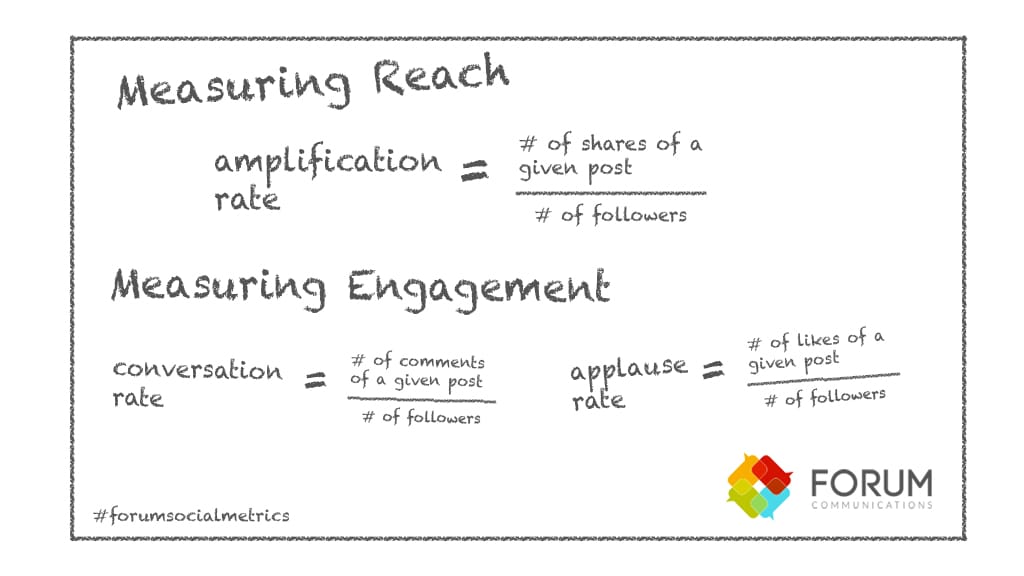Social Media Metrics: What Matters and Why

One of the many questions we’re frequently asked is what value does social media bring to the bottom line. That’s a difficult question. Social media can, at times, drive direct sales, but it can also do so much more. At Forum, this is how we see social media and the metrics used to measure success and failure.
What is social media used for in marketing?
 One of the ongoing frustrations for businesses is how they show return on investment for their social media efforts. Sometimes that’s simple. However, for others, sometimes it’s not as simple.
One of the ongoing frustrations for businesses is how they show return on investment for their social media efforts. Sometimes that’s simple. However, for others, sometimes it’s not as simple.
Let’s be honest – social media isn’t where your sales are typically going to come from. While it is possible to drive awareness, interest, and even consideration for your products and services via social media channels like Facebook – you most likely aren’t going to see some dramatic uptick in sales from having an amazing social media effort. That’s not what social media does.*
Social media is primarily used to drive awareness, consideration, loyalty and advocacy with a strong emphasis on the latter two. Most followers on social media are already customers. They appreciate your work and want more information from you via social. Many times, if your brand is strong and your service is excellent, social media can be a great channel for customer service and retention of existing customers. If you remember from business 101, it is more expensive to find a new customer than it is to retain an existing customer. Social media should help lower your marketing costs by strengthening brand advocacy, or that is, the number of people who love you.
What do we track in social media and why?
Since we’re focused on understanding how much people love us – wanting to continue the conversation with leads and/or existing customers and drive advocacy – we care about a number of different metrics. We want people to react to our content in a positive way. Each channel is different. With Facebook, it’s followers, likes, comments, and shares as measures of engagement and advocacy. On Twitter, it’s followers, likes, replies, and retweets. On Instagram, it’s followers, likes, and comments. On Youtube, it’s followers, likes, and comments.
All of this is dependent on the strategy for the given channel. We may care more about one area than we do another. That’s really basic though.
There are also other things that we can measure. Let’s break these other items down into four areas: volume, reach, engagement, and influence.
Volume
Social media volume is about the “size” of the conversation about your brand and/or campaign. This can be hard to determine for local campaigns, however, as an effort becomes more regional, national, or even international, this is a little easier. Measuring volume is more than just a tweet or a post, but more about measuring the number of messages about the brand, how many people are talking about the brand over time and the changes that occur. If the brand is large enough, we can measure whether volume moves higher or lower during certain times of the day and/or pick which physical locations have the most positive or negative buzz. This requires special social media listening software to track effectively.
Reach
Another thing we can measure is reach. This is the spread of a social media conversation. How far is the content reaching and how large is the overall audience. Reach doesn’t tell us the entire story but it can be extremely powerful when combined with other metrics. When used with clicks, retweets, replies, etc., it provides engagement metrics that can be very helpful. Again, this is more powerful the larger a brand becomes.
One of the calculations that we would focus on with reach would be amplification rate. Amplification rate is a measure of how far our content reaches. It is the ratio of shares per post to the number of followers.
Amplification Rate (as a percentage) = # of shares of a given post / # of followers
Engagement
As I mentioned earlier, social media is focused on the top and bottom of our marketing funnel with emphasis on loyalty and advocacy. What’s the best way to maintain a relationship? Remain engaged – which makes engagement one of our most important areas to measure.
Engagement is about how many people participate in the conversation with us and what they are doing to spread our content and engage on the topic. In engagement, we pay attention to retweets, shares, and posts about us as well as the comments, replies and likes that show how engaged our followers are. Second, we want to know who they are and are they influential in their circles. For instance, if we have an article that was shared 5 times, but they’re all employees and no customers…we need to work on building content that would encourage customers to share, not just employees.
Also, we have to go back to our goal. What kind of interaction did we anticipate with that piece of content. Did we expect shares or did we anticipate reactions? That matters for each post.
Engagement also includes elements of website traffic. If we’re posting articles from our blog, like this post, are people clicking through on social media? If so, are they bouncing or continuing on to look at other content? How much traffic are we driving from social media? How engaged are visitors on our website from social media? Those things matter and indicate valuable information about your website.
Just like reach, there are also a few calculations we can look at. The first is the rate of conversation or conversation rate. This simply shows how engaged our users are in being willing to engage with us on social media. On Facebook, this would be the # of comments / # of followers.
Conversation Rate (as a percentage) = # of comments of a given post / # of followers
Applause rate is similar but different. Applause is the ratio of likes per post to the number of followers. This doesn’t really show as much engagement as it does interest in the content you’ve posted. It is also measured as a percentage.
Applause Rate (as a percentage) = # of likes of a given post / # of followers
Now, we know you’re going to ask…for each of these, is there an industry average? Well, to be honest, if they exist, we haven’t seen them yet. We know a number of software companies like TrackMaven produce reports based on their customer data, but we haven’t seen these broken out by industry as, well, a lot of companies and/or agencies don’t track down to the post level. And, if they do, they don’t share that data. We believe it is more important to track these things for your own organization than to look at industry or national averages. Set your benchmark with your past few posts and work to improve it over time.
Influence
This one is a popular one but it doesn’t actually mean what you think it means. Followers do not equate to influence. Influence is a measure of power and, well, influence. For instance, if we have almost 2,000 connections on LinkedIn, but some of them influence us much, much more than we may influence them. Maybe they are acquaintances and mavens in our field but because we’ve met once doesn’t mean that we influence their behavior in any way.
Influence is more difficult to measure but when you have real influence you know it. Plus, your influence helps improve more top of the funnel activities like brand awareness and consideration because people care more about the content you can provide.
Tools like Klout used to be helpful. Now, Skorr, an app released in 2018, is using artificial intelligence to measure influence.
Share of Voice
One other thing we may want to consider is share of voice. Of all your competitors, who has the most conversation on social media? This is a good way to view your efforts, however, this can shift quickly and should be measured in both positive and negative buzz. Also, dependent on your organization’s size, this may be too difficult to measure. A simple way to look at this in Facebook is viewing your competitors in Facebook Insights and seeing who has the most followers and most engagement.
What else should we track?
Well, that again depends on your social media strategy. There are tons of other great articles about social media metrics from many of the software companies like HootSuite, Sprout Social and others. Check out their advice as well and see what best fits your strategy.
*NOTE: LinkedIn is an outlier if used effectively for B2B marketing. It can be a sales channel and can get the sales conversation started if used effectively.
Back
